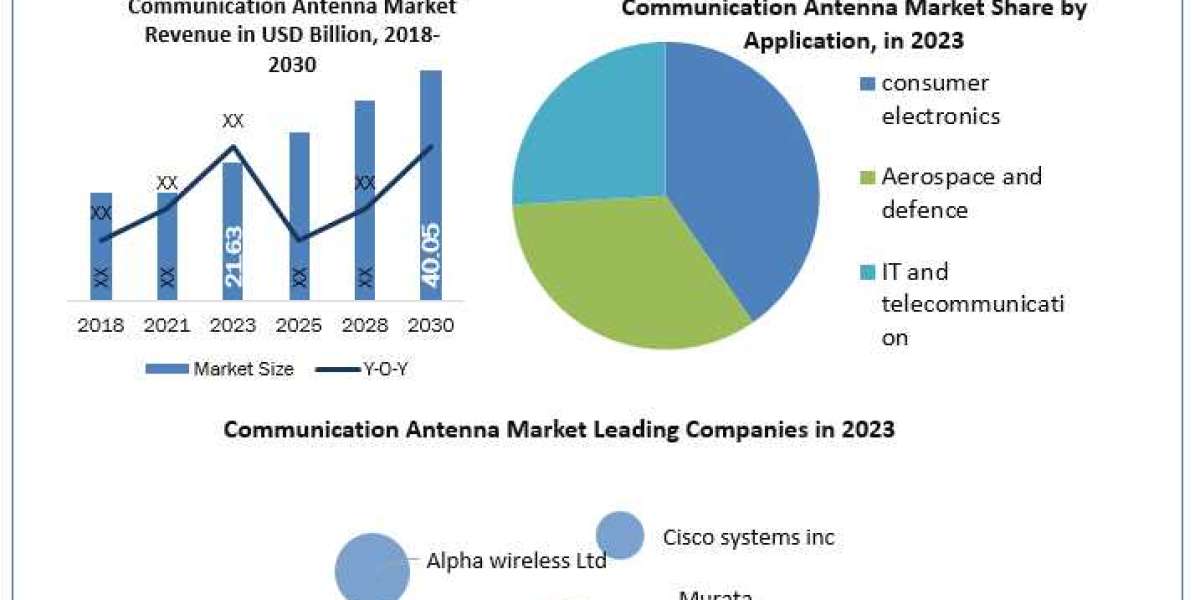global communication antenna Market Forecast
The Global Communication Antenna Market size was valued at USD 19.81 billion in 2023 and is expected to reach USD 33.77 billion by 2030, growing at a CAGR of 9.2% during the forecast period (2024–2030).
This growth is driven by technological advancements, the increasing demand for highspeed communication, and the proliferation of connected devices worldwide.
The global communication antenna market is witnessing significant growth as demand for advanced, highperformance antennas continues to rise across various industries. Communication antennas are essential devices that facilitate the transformation of radio frequency (RF) signals into electromagnetic waves, enabling effective transmission of data. These antennas play a crucial role in industries such as telecommunications, defense, automotive, healthcare, and more, providing reliable, highspeed communication and data transfer capabilities.
Market Overview: Driving Forces Behind Antenna Demand
Communication antennas are vital components in modern communication systems, offering high bandwidth and reduced interference to optimize frequency reuse and extend coverage. In telecommunications, antennas support faster data transmission, enhanced network evolution, and seamless connectivity for consumers and businesses. The increasing adoption of wireless communication technologies, such as 5G, IoT, and RFID, is driving the demand for more sophisticated antenna solutions.
Request for free sample: https://www.stellarmr.com/report/req_sample/Communication-Antenna-Market/1424
Key applications include:
Telecommunications: Antennas are integral to cellular networks, especially with the advent of 5G technology, enabling highspeed data transfer.
Autonomous Vehicles: Antennas are used for tracking, vehicletovehicle communication, and navigation systems.
Satellite Communication: Enabling global connectivity, even in remote or inaccessible regions.
RFID Systems: Used for tracking shipments, inventory management, and security systems in commercial and ecommerce applications.
Radar Systems: For applications in defense and aerospace, providing surveillance and navigation capabilities.
The advent of metamaterials and smart antennas is revolutionizing wireless communication, further fueling growth. Smart antennas enhance the performance of wireless networks by adapting to the environment and optimizing signal reception and transmission, which is crucial for mobile communication and IoT applications.
Market Segmentation
The communication antenna market is broadly segmented by type, coverage, application, industry vertical, and geography. The key segments include:
1. By Type:
Wire Antenna: Traditional antennas with wideranging applications.
Aperture Antenna: Known for high gain and focused radiation.
Lens Antenna: A growing technology offering directional transmission with high precision.
Microstrip Antenna: Lightweight, compact, and suitable for mobile applications.
2. By Coverage Type:
Directional Antennas: Focus on specific directions, ideal for longrange communications.
OmniDirectional Antennas: Offer 360degree coverage, suitable for generalpurpose use.
SemiDirectional Antennas: A mix of the above, catering to a range of applications.
3. By Product Type:
Macro Cells: Largescale antennas for widearea coverage.
Small Cells: Compact, localized antennas that support highdensity urban areas and enhance network capacity.
4. By Technology:
MIMO (Multiple Input Multiple Output): Enhances signal capacity and quality, especially for highspeed mobile networks.
SIMO/MISO: Technologies used in wireless communication for optimizing signal quality.
Lens Antenna: Gaining popularity for its precision and high performance.
5. By Industry Vertical:
Telecommunications: The largest contributor to the market, driven by the rise in mobile device penetration and 5G adoption.
Aerospace and Defense: For communication, surveillance, and navigation systems.
Automotive: Antennas in autonomous vehicles and connected car systems.
Healthcare: Applications in medical devices and telemedicine.
Consumer Electronics: In smartphones, wearables, and IoT devices.
Request for free sample: https://www.stellarmr.com/report/req_sample/Communication-Antenna-Market/1424
Market Dynamics: Drivers, Restraints, and Opportunities
Drivers
Rising Demand for Smart Antennas: With the increasing need for efficient, stable, and highperformance networks, particularly in 5G and IoT ecosystems, smart antennas are seeing widespread adoption.
Increased Mobile Device Penetration: The rising number of mobile users, especially in emerging economies, is creating a substantial demand for antennas that support mobile communication and highspeed internet access.
IoT and Wearable Technologies: The growth of connected devices, including wearables and smart home products, is driving the need for specialized antennas that can handle multiple wireless communication protocols such as WiFi, Bluetooth, Zigbee, and NFC.
Advancements in 5G Networks: As 5G technology continues to roll out globally, the demand for advanced antenna solutions, particularly for small cells and highfrequency bands, is rising.
Restraints
High Cost and Maintenance: The initial cost of advanced communication antennas, especially smart and highgain antennas, can be a barrier to adoption for certain businesses, particularly in developing regions.
Wear and Tear: The degradation of antennas due to environmental exposure, wear, and tear can hinder their performance, particularly in harsh conditions.
Complexity of Deployment: Designing, installing, and maintaining communication antenna systems can be complex, requiring specialized knowledge and expertise.
Opportunities
Government Investments in Defense: Increased defense spending, particularly in surveillance and communication systems, presents significant opportunities for the growth of communication antennas in the aerospace and defense sectors.
Emerging Economies: Rapid urbanization and increased internet penetration in developing regions, such as AsiaPacific, Africa, and Latin America, are creating substantial demand for reliable communication infrastructure.
IoT and Smart Cities: The proliferation of IoT devices and smart city initiatives presents a growing market for antennas capable of supporting various wireless protocols.
Regional Analysis
North America:
Dominated by the U.S., which leads the global market in mobile device penetration, 5G adoption, and defense sector spending.
High demand for antennas in the aerospace and defense sectors, along with consumer electronics, positions North America as a key market.
Europe:
The European market is experiencing growth in wireless communication technologies, especially in the automotive and industrial sectors.
The region's focus on 5G deployment and smart city development is expected to drive market expansion.
AsiaPacific:
The fastestgrowing market due to increasing investments in telecommunications infrastructure, particularly in countries like China, India, and Japan.
Strong demand for antennas supporting 5G, IoT, and consumer electronics, coupled with the presence of major smartphone and electronics manufacturers, is driving growth.
Latin America and MEA:
Emerging economies in Latin America and the Middle East and Africa are witnessing increased demand for wireless communication networks, particularly in urban and industrial sectors.
With significant infrastructure development in these regions, the market for communication antennas is expected to expand rapidly.
Competitive Landscape
The communication antenna market is highly competitive, with key players focusing on technological advancements, strategic partnerships, and geographic expansion to maintain market share. Leading companies in the market include:
Alpha Wireless Ltd.
Cisco Systems Inc.
Murata Manufacturing Co. Ltd.
TE Connectivity Ltd.
Laird Technologies PLC
Amphenol Corp.
Qualcomm Inc.
Pulse Electronics Corp.
These companies are investing heavily in RD to develop nextgeneration antennas that cater to the evolving needs of 5G, IoT, and other advanced communication systems.
Conclusion
The communication antenna market is set for significant growth over the coming years, driven by technological advancements in 5G, IoT, and defense sectors, as well as the increasing adoption of wireless communication in emerging markets. While challenges such as high costs and maintenance issues persist, the opportunities presented by smart antennas and the global expansion of communication infrastructure provide a promising outlook for the market.







